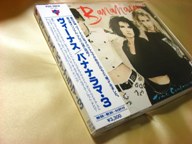<< tips about CDs pressed/released in Japan >>
If you are collecting, or willing to collect Japanese CDs,
you'd better know some things about
CDs pressed/released in Japan
On this blog, there are some tips which may help you getting BETTER ones.
... we might have forgotten some others, but this is what the 1st/2nd letters of the catalog number means.
Some labels in the above list had already disappeared because of mergers of companies etc.
CBS/SONY, EPIC/SONY are now a part of SONY INTERNATIONAL.
VIRGIN JAPAN became a inner section of TOSHIBA EMI.
APOLLON is now ROADRUNNER JAPAN.
NIPPON PHONOGRAM, POLYDOR are now in UNIVERSAL group.
Therefore, CDs will NOT be re-issued with the old catalog numbers if the original label disappears, and that is why there are many versions of the same title in Japan..
*-* CATALOG NUMBER *-*
There are some secrets at "CATALOG NUMBER" of Japan pressing CDs. This may be one of the most unique points of Japan Edition CDs.
Here, we talk about catalog numbers of Record Labels who are joining in
NIHON-RECORD KYOKAI
(Recording Industry Association of Japan / RIAJ).
Most of major labels are members of RIAJ, like
NIHON-RECORD KYOKAI
(Recording Industry Association of Japan / RIAJ).
Most of major labels are members of RIAJ, like
TOSHIBA EMI
SONY (CBS/EPIC and other SONY)
PONY CANYON
UNIVERSAL (POLYDOR)
VICTOR ENTERTAINMENT
WARNER
ALFA
AVEX
APOLLON/ROADRUNNER JAPAN
etc.
If you have any JAPAN-EDITION CD in your shelf, please check the catalog number.
If your CD is "released after 1992 version" the number may be like this,
? ? C ? - 1 2 3 4
for example,
if yours is from TOSHIBA EMI, the catalog number may start from
TOCP, TOCJ, TOCE etc.
if it was SONY, CBS/SONY or EPIC/SONY, it may be
SRCS, CSCS, ESCA, SICP etc.
Of course, other labels also have their own patterns of the catalog numbers, and now,
there is 1 thing we can find in those "4 letters".
The 3rd letter is always "C".
PCCY.POCP.WPCP.AMCY.RRCY.APCY.UICL.VICP.ALCB.AVCD..PHCR......
There are many well-known catalog numbers (former 4 letters), but there is "C" on the 3rd portion on all catalog numbers.
The reason is very easy. The "C" means "CD".
If you have DVD-AUDIO (from Japan), the 3rd letter is "A"m and if yours is BLU-RAY (from Japan), it should be "X". That is, it changes by the sort of the products.
Then, what is the 1st, 2nd and the 4th letters?
It's easy as the 3rd letter, too. If you'll learn this, you may remember many catalog numbers easily.
The 1st/2nd letters means the LABEL.
Here we list some major ones.
Here we list some major ones.
"SRCS" ... SONY RECORDS
"CSCS" ... CBS/SONY
"ESCA" ... EPIC/SONY
"SICP" ... SONY INTERNATIONAL
"AMCY" ... ATLANTIC/MMG (WARNER)
"WPCP" ... WARNER-PIONEER
"WPCP" ... WARNER-PIONEER
"TOCP" ... TOSHIBA EMI
"VICP" ... VICTOR ENTERTAINMENT
"BVCP" ... BMG VICTOR
"MVCM" ... MCA VICTOR
"VICP" ... VICTOR ENTERTAINMENT
"BVCP" ... BMG VICTOR
"MVCM" ... MCA VICTOR
"CRCL" ... NIPPON CROWN
"KICP" ... KING RECORDS
"VJCP" ... VIRGIN JAPAN
"UICL" ... UNIVERSAL INTERNATIONAL
"PHCR" ... NIPPON PHONOGRAM
"PCCY" ... PONY CANYON
"POCP" ... POLYDOR
"TECW" ... TEICHIKU
"TKCF" ... TOKUMA JAPAN
"APCY" ... APOLLON
"RRCY" ... ROADRUNNER JAPAN
"MICP" ... MARQUEE INCORPORATED
"TFCK" ... TOY'S FACTORY
"ALCB" ... ALFA
"AVCD" ... AVEX
"XRCN" ... ZERO (XERO) CORPORATION
"VJCP" ... VIRGIN JAPAN
"UICL" ... UNIVERSAL INTERNATIONAL
"PHCR" ... NIPPON PHONOGRAM
"PCCY" ... PONY CANYON
"POCP" ... POLYDOR
"TECW" ... TEICHIKU
"TKCF" ... TOKUMA JAPAN
"APCY" ... APOLLON
"RRCY" ... ROADRUNNER JAPAN
"MICP" ... MARQUEE INCORPORATED
"TFCK" ... TOY'S FACTORY
"ALCB" ... ALFA
"AVCD" ... AVEX
"XRCN" ... ZERO (XERO) CORPORATION
... we might have forgotten some others, but this is what the 1st/2nd letters of the catalog number means.
Some labels in the above list had already disappeared because of mergers of companies etc.
CBS/SONY, EPIC/SONY are now a part of SONY INTERNATIONAL.
VIRGIN JAPAN became a inner section of TOSHIBA EMI.
APOLLON is now ROADRUNNER JAPAN.
NIPPON PHONOGRAM, POLYDOR are now in UNIVERSAL group.
Therefore, CDs will NOT be re-issued with the old catalog numbers if the original label disappears, and that is why there are many versions of the same title in Japan..
our ebay store
SANREMO PORTAL SITE (our main page)
*/ introducing links to our ebay STORE
(there you can choose ebay COM, CA, DE, IT, FR and/or more and more ebay)
*/ introducing our BLOGS and information of something about Japanese goods.
*/ introducing links to our ebay STORE
(there you can choose ebay COM, CA, DE, IT, FR and/or more and more ebay)
*/ introducing our BLOGS and information of something about Japanese goods.





























